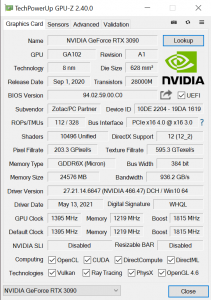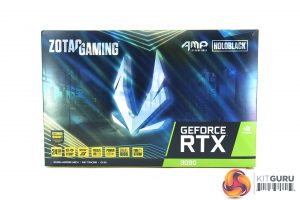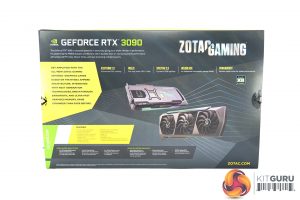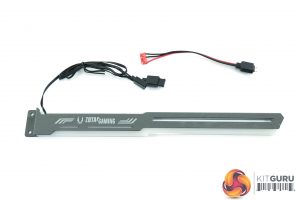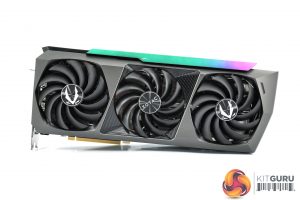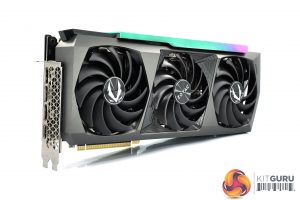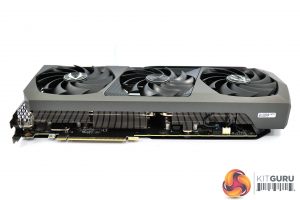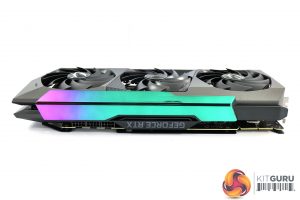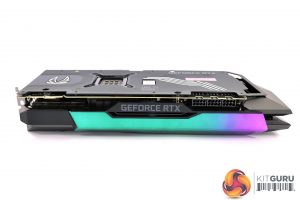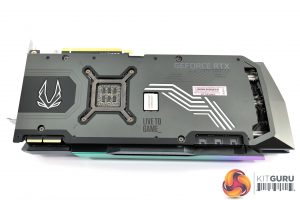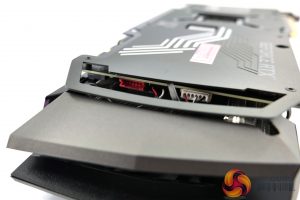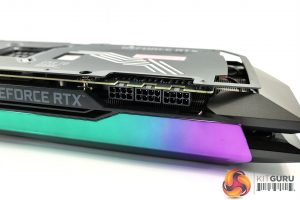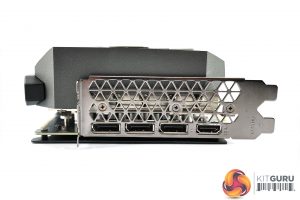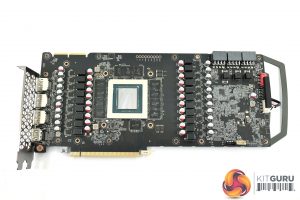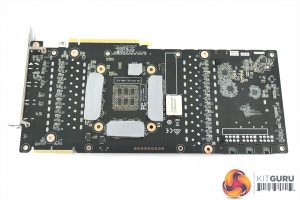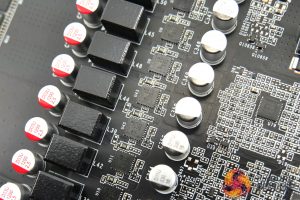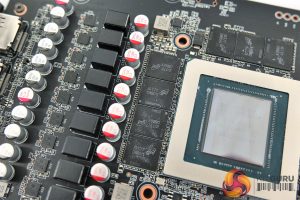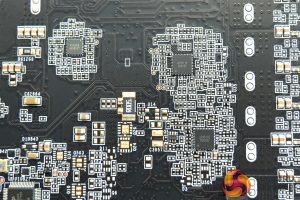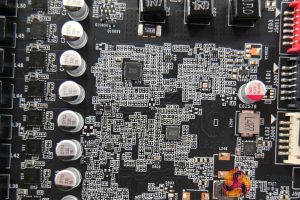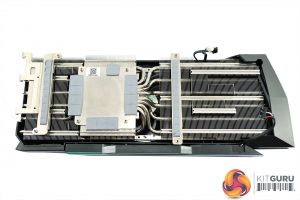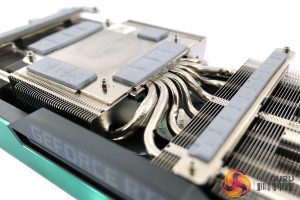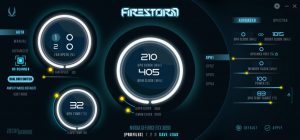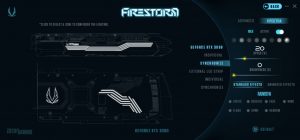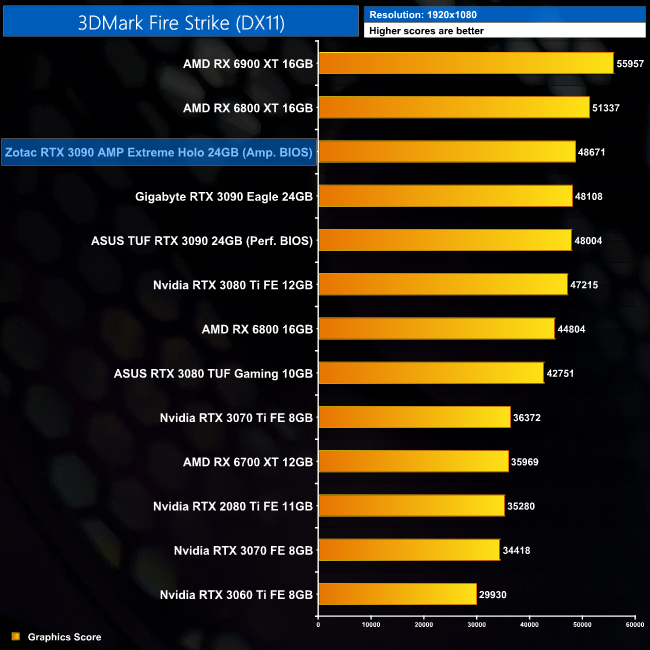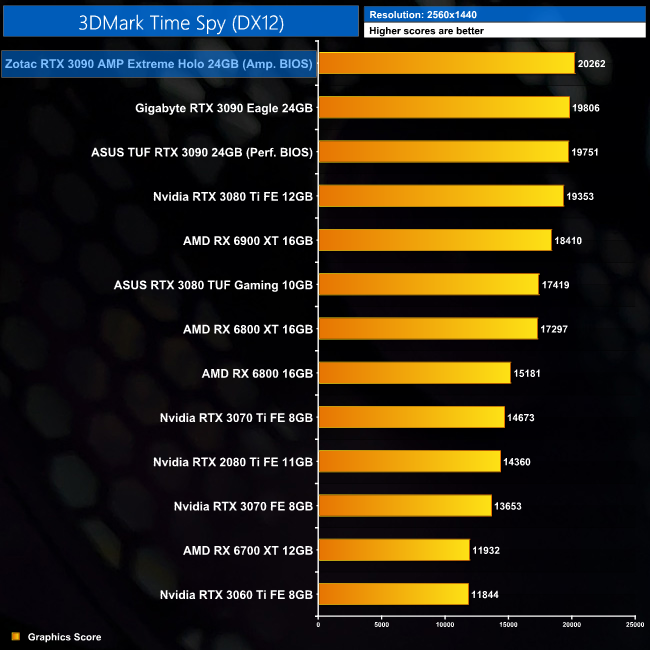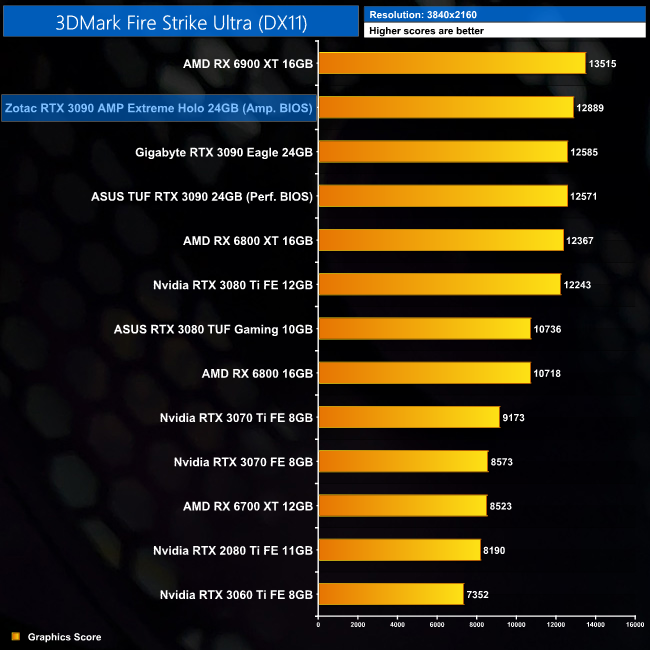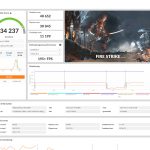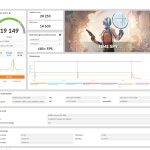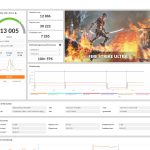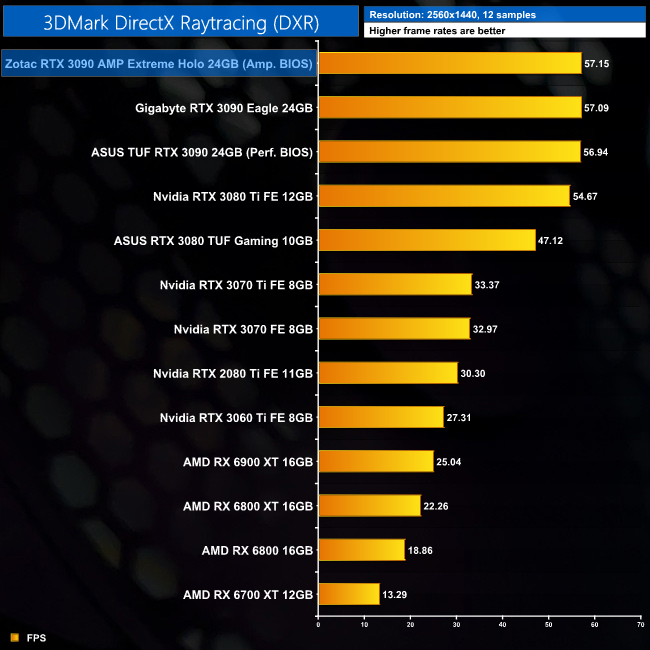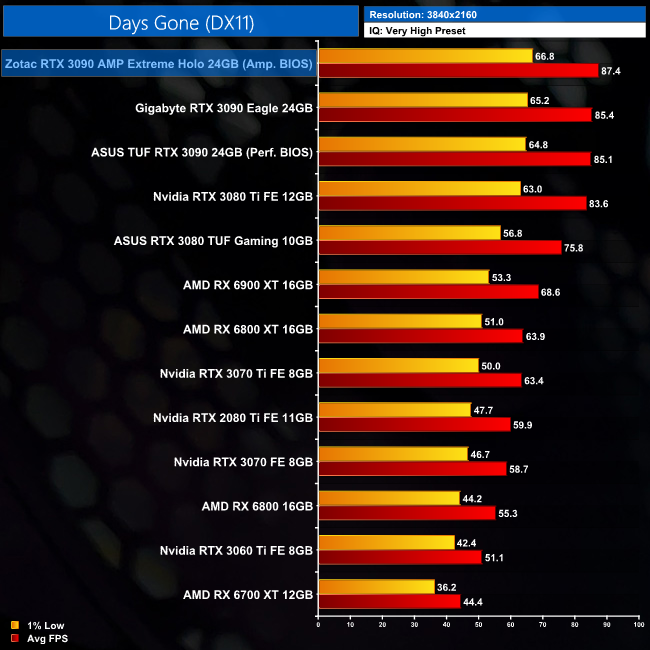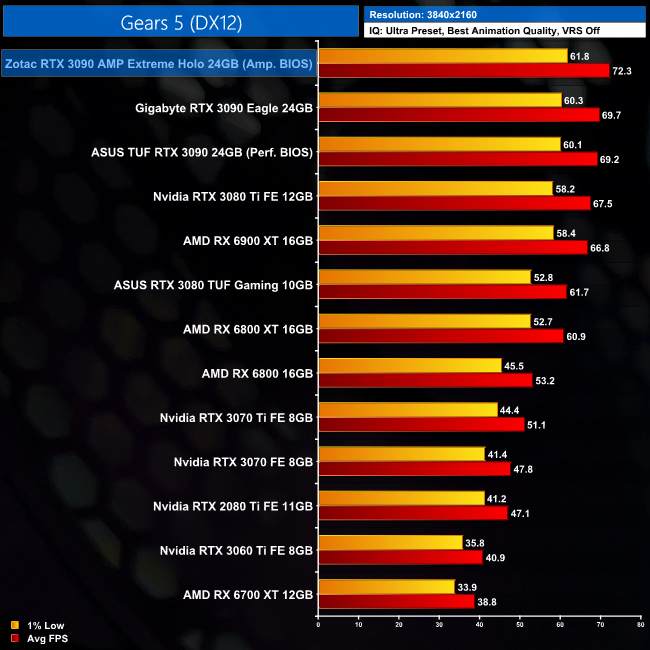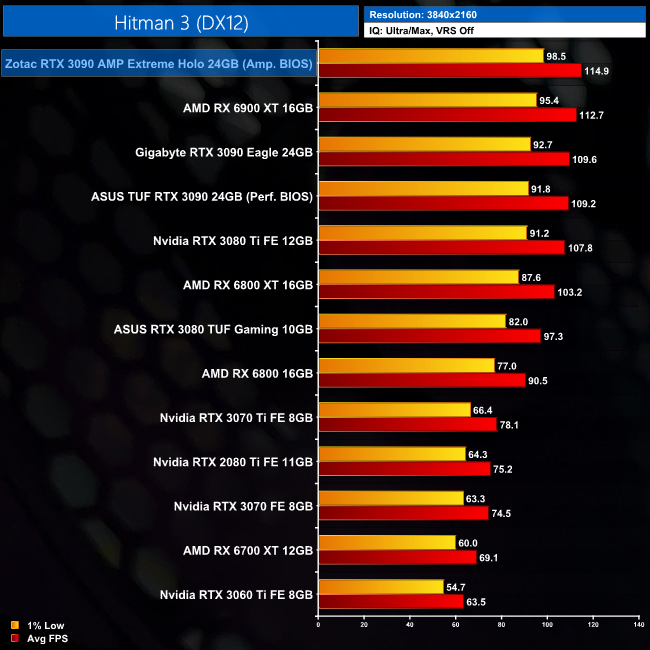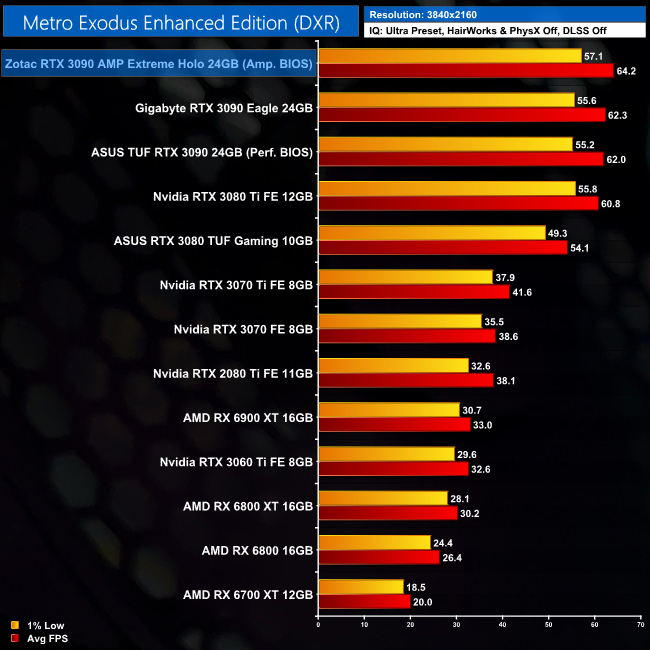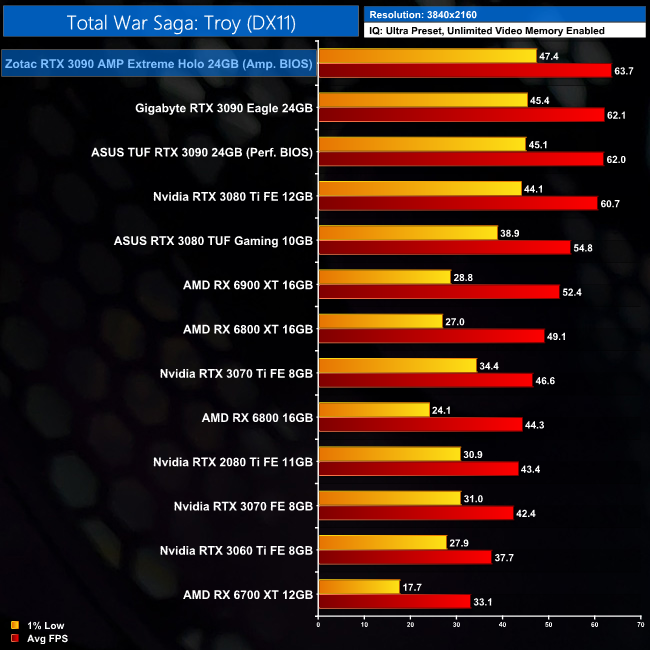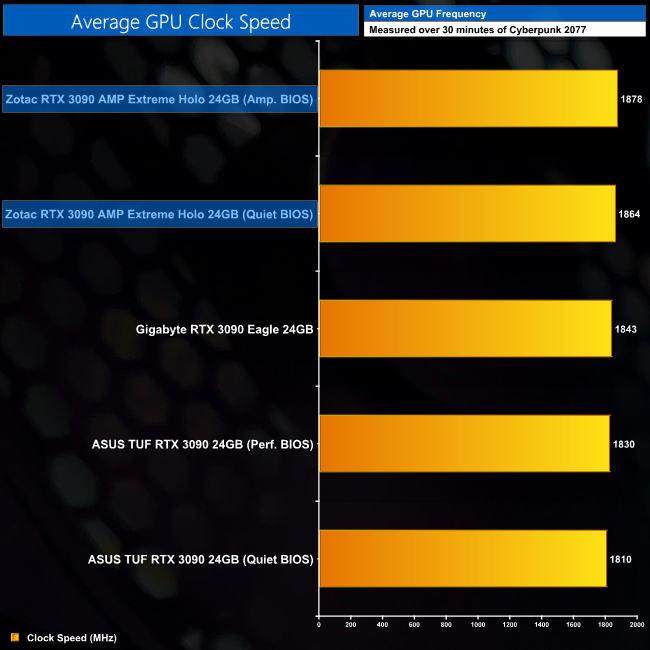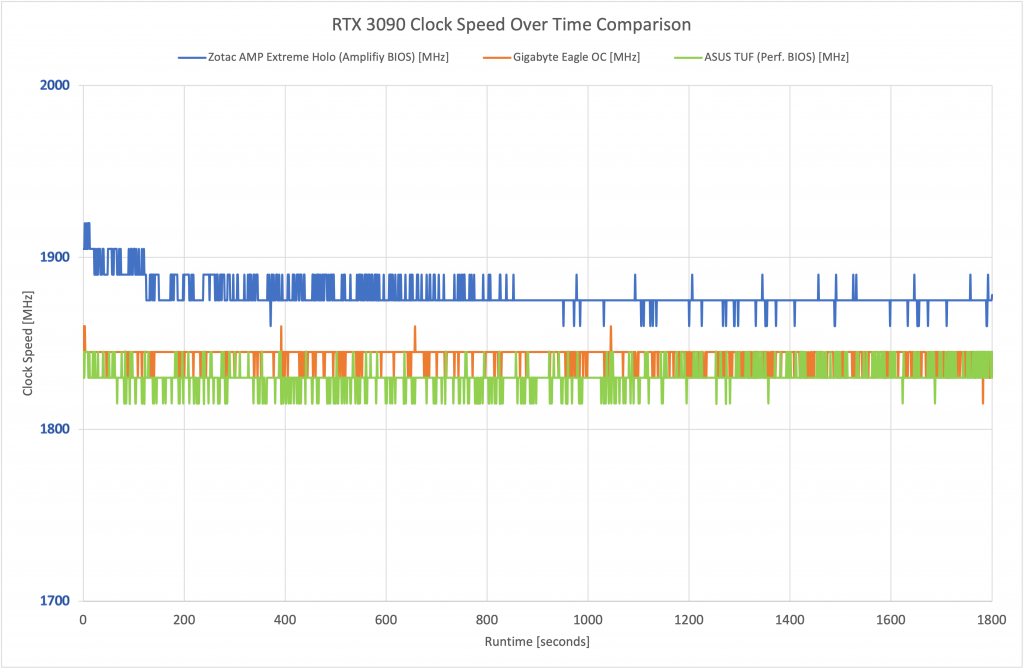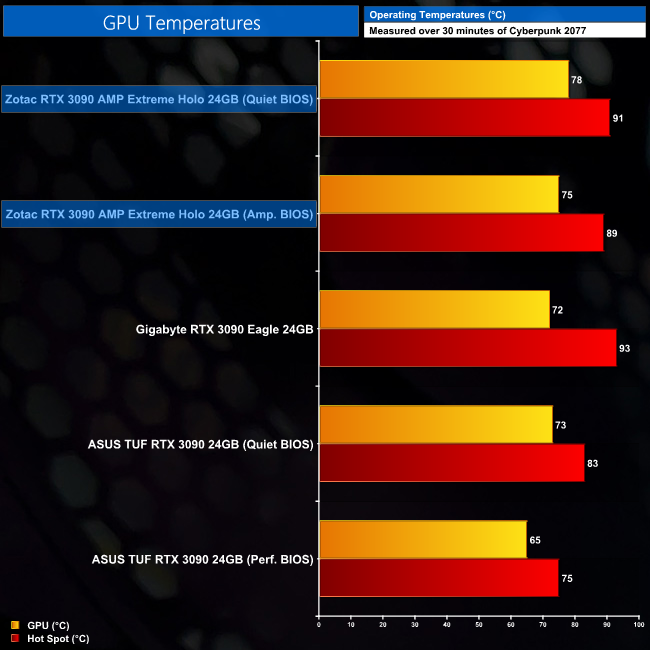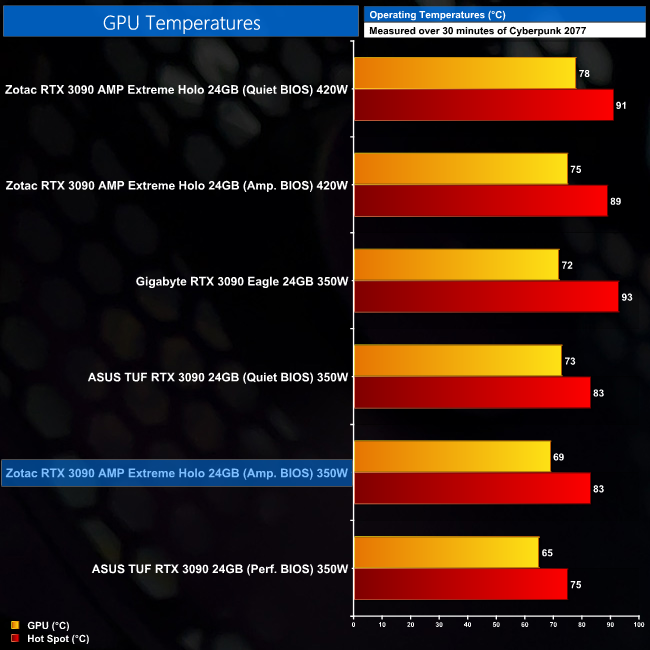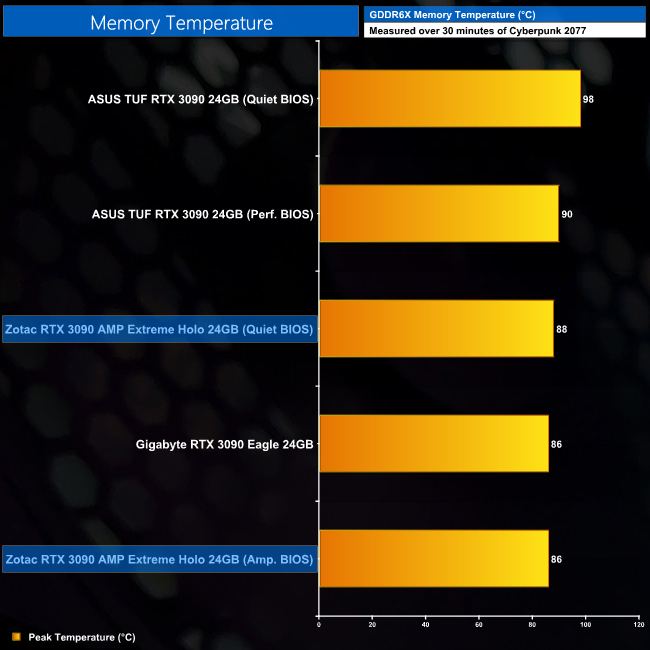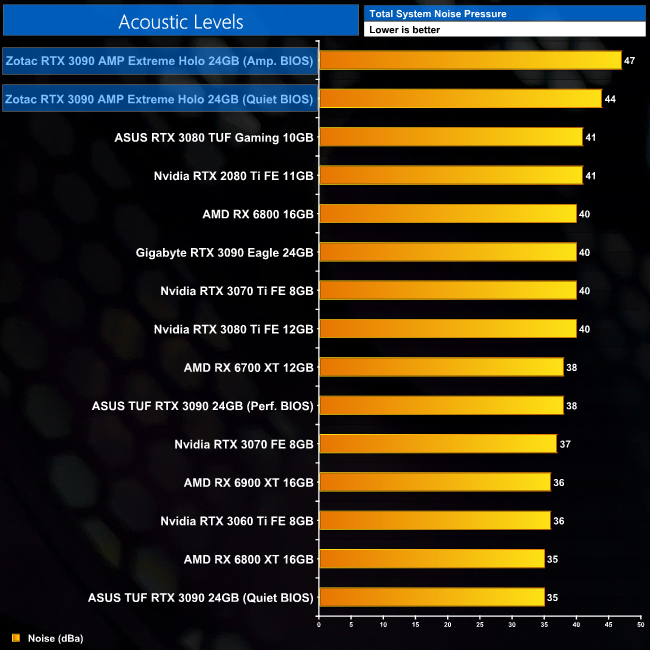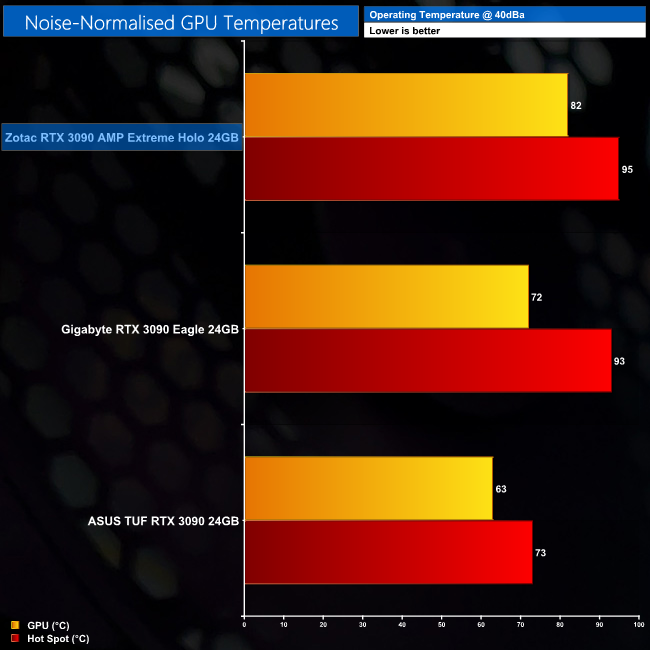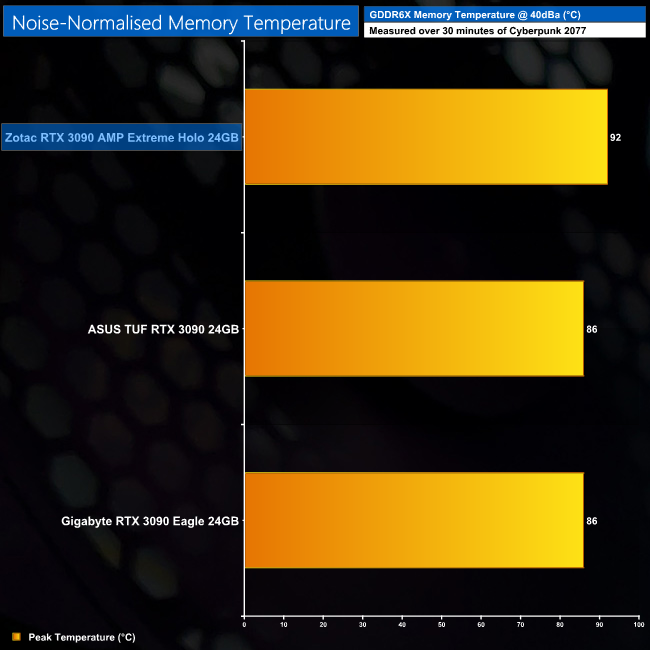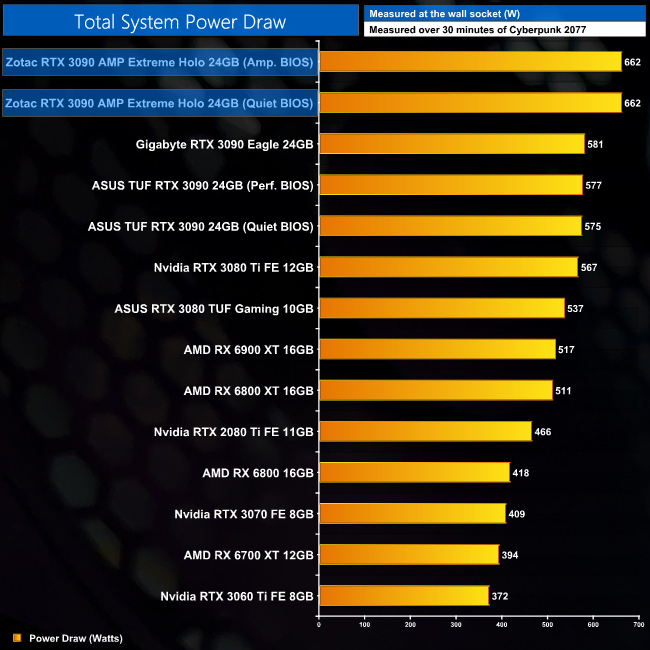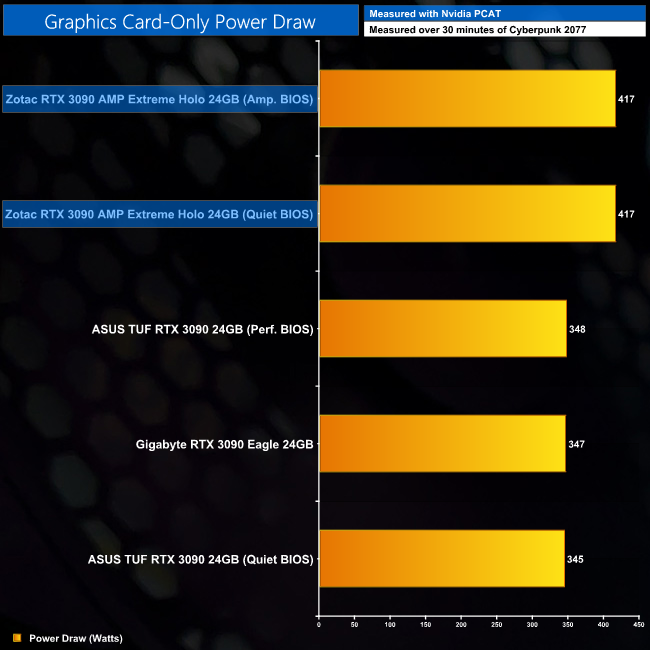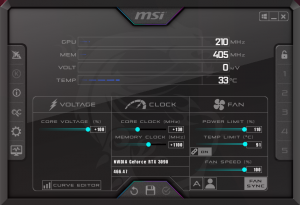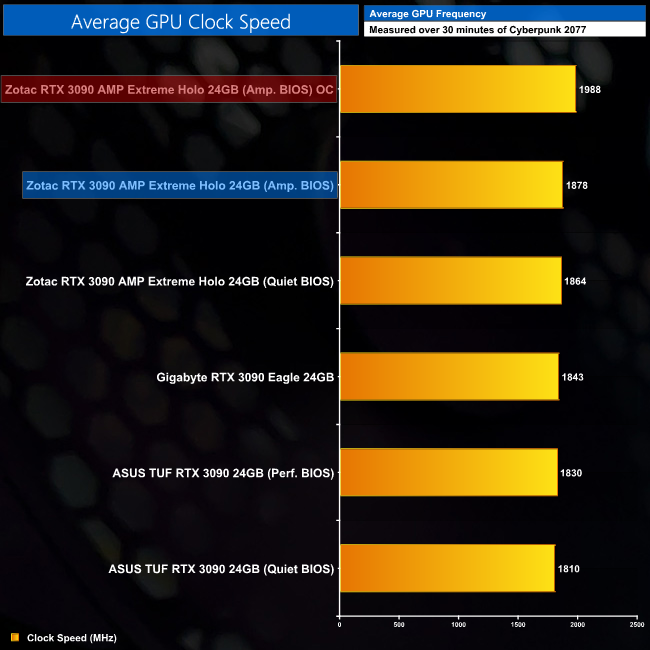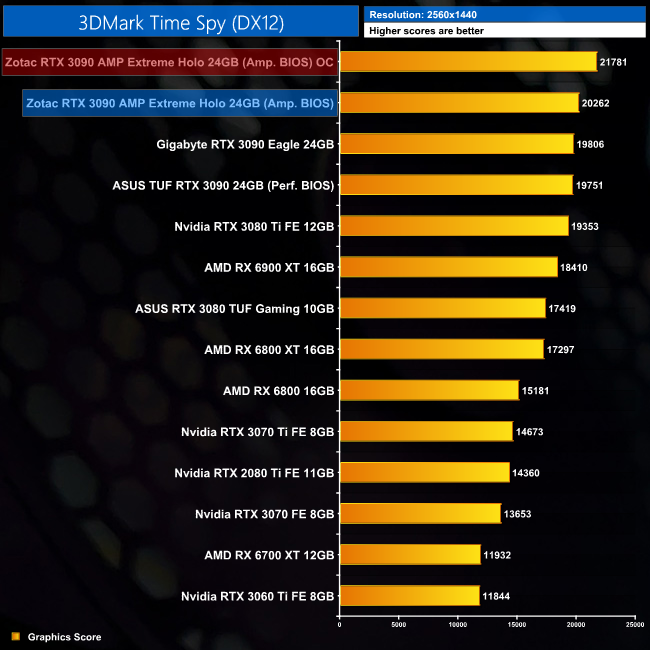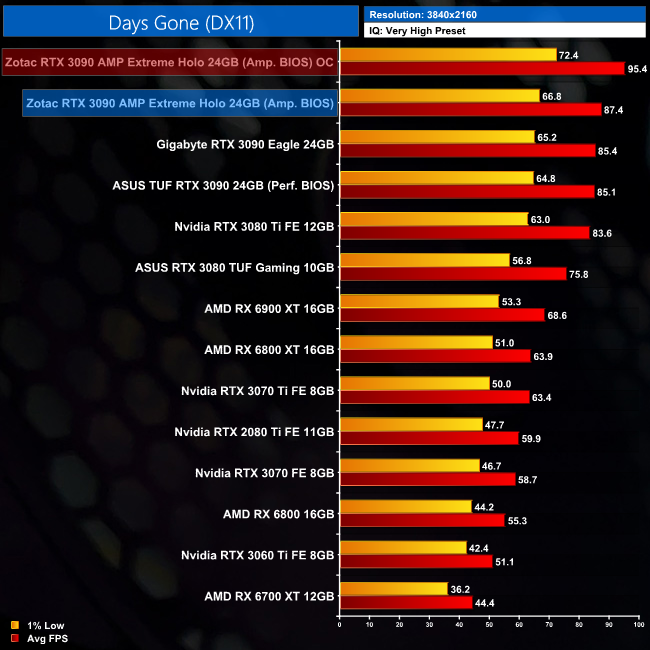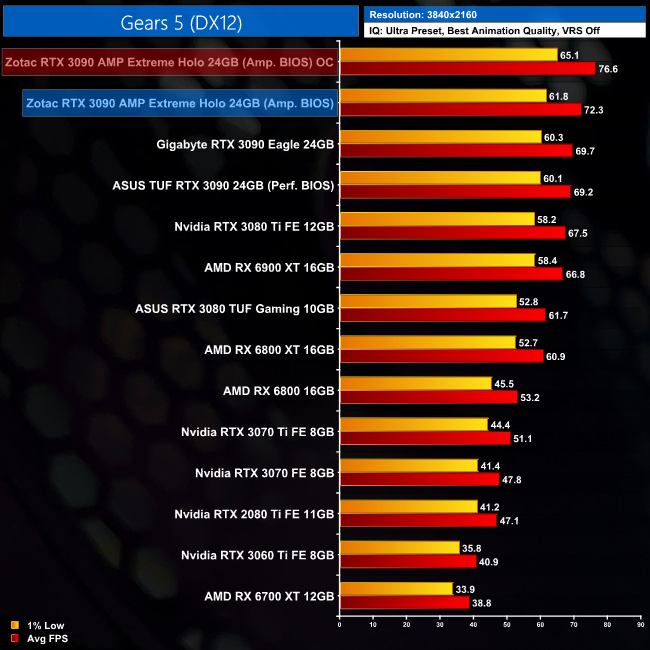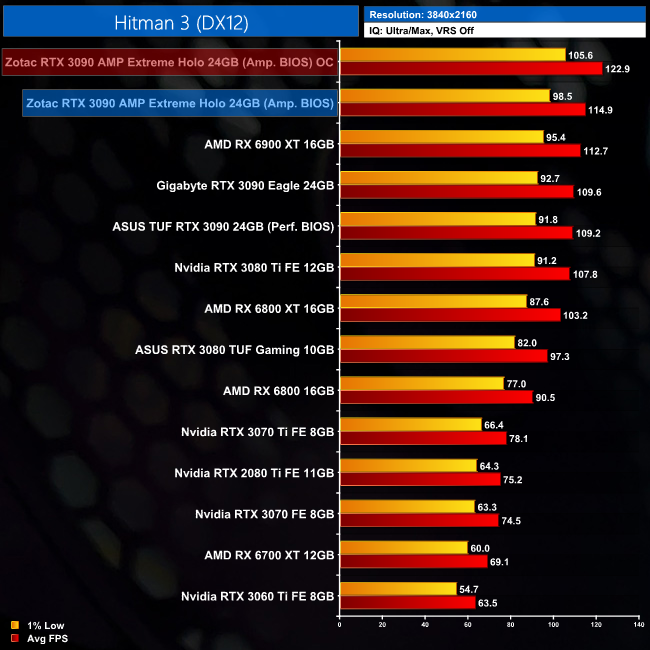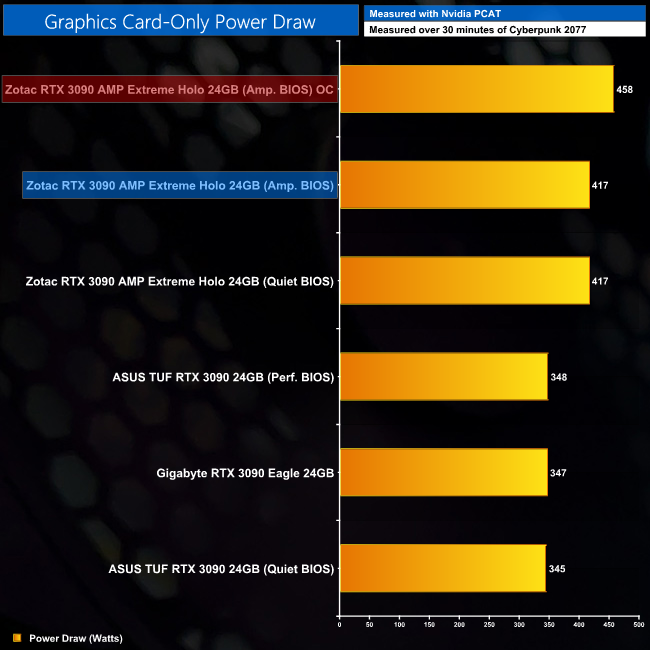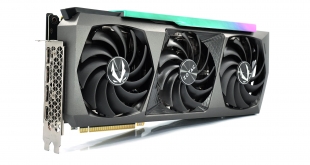
It's been some time since we last looked at a graphics card based on Nvidia's flagship RTX 3090 GPU, but that changes today with our review of Zotac's new RTX 3090 AMP Extreme Holo. The company's top-tier SKU, the AMP Extreme Holo sports an immensely large cooler, bling-tastic RGB implementation, plus a 420W power target to ensure you are getting every last drop of performance from the GA102 silicon.
The Zotac RTX 3090 AMP Extreme Holo certainly isn't for the faint of heart. Aside from its sheer size – it measures in over 35cm long – it features a bold and RGB-heavy design, which is likely to split opinion. From a technical perspective however, with a 420W power target plus a 120MHz factory overclock compared to reference specifications, it sounds very exciting indeed. Let's dive in and see what this card is all about.
| RTX 3090 | RTX 3080 Ti | RTX 3080 | RTX 3070 | RTX 3060 Ti | |
| SMs | 82 | 80 | 68 | 46 | 38 |
| CUDA Cores | 10496 | 10240 | 8704 | 5888 | 4864 |
| Tensor Cores | 328 | 320 | 272 | 184 | 152 |
| RT Cores | 82 | 80 | 68 | 46 | 38 |
| Texture Units | 328 | 320 | 272 | 184 | 152 |
| ROPs | 112 | 112 | 96 | 96 | 80 |
| GPU Boost Clock | 1695 MHz | 1665 MHz | 1710 MHz | 1725 MHz | 1665 MHz |
| Memory Data Rate | 19.5 Gbps | 19 Gbps | 19 Gbps | 14 Gbps | 14 Gbps |
| Total Video Memory | 24GB GDDR6X | 12GB GDDR6X | 10GB GDDR6X | 8GB GDDR6 | 8GB GDDR6 |
| Memory Interface | 384-bit | 384-bit | 320-bit | 256-bit | 256-bit |
| Memory Bandwidth | 936 GB/Sec | 912 GB/Sec | 760 GB/Sec | 448 GB/Sec | 448 GB/Sec |
| TGP | 350W | 350W | 320W | 220W | 200W |
RTX 3090 uses the GA102 GPU, which also forms the basis for RTX 3080. Even with its 82 SMs, however, this is not actually a full implementation of GA102, as a fully populated die houses 84 SMs, so just two are missing from the RTX 3090. Ampere has doubled the number of FP32 shaders per SM, so there’s a total of 128 CUDA Cores in each of those 82 SMs, for a grand total of 10496.
Each SM also houses a single RT Core, as well as four Tensor cores, giving us 328 with the RTX 3090. Additionally, there’s 328 texture units and 112 ROPs.
As for the memory, this is a significant step up from the RTX 3080. RTX 3090 of course still uses GDDR6X memory, but it has over double the amount with 24GB. Additionally, the modules are clocked slightly faster at 19.5Gbps, and the memory interface is also slightly wider than RTX 3080, with a 384-bit interface. Total memory bandwidth comes in just shy of 1TB/s, hitting 936 GB/s.
RTX 3090 defaults to a boost clock of 1695MHz, but Zotac has added 120MHz to this, bringing it up to 1815MHz. Later in the review we test exactly how fast this GPU actually operates, as we would expect GPU Boost to bring clock speed well above the rated speed.
Power draw has also been increased with the AMP Extreme Holo, up from 350W to 420W. It will be interesting to see how that affects GPU cooling as well.
The Zotac RTX 3090 AMP Extreme Holo ships in an eye-catching blue box, with Zotac's logo occupying most of the front. On the back we find two images of the card, as well as some key features and specifications.
A whole ton of documentation comes included, but more interesting is the metal support bracket, which is also RGB enabled. You can see it in action in the RGB showcase video at the bottom of this page. We do have to note however, a rubber piece is meant to come included to sit between the graphics card and the bracket itself, but no such piece was to be found with my sample.
Moving onto the card itself though, your eye is probably drawn first to the multi-coloured section that sits on the side of the card. This is actually one of the RGB zones on the card, as we can see below.
The shroud of the card is less special though, as it is made of grey plastic. It doesn't feel weak or flimsy, but compared to the likes of the ASUS TUF series that use all-aluminium shrouds, it neither looks nor feels as premium. We're hopeful about the cooling though, as Zotac is using three 100mm fans here, each sporting 11 fan blades.
In terms of the sheer size of the card, you will need a fairly roomy case to actually get this installed. That's because it measures 352.9mm x 144.7mm x 59.7mm… so don't expect to be installing this in your mini-ITX chassis! I believe this is the largest graphics card I have ever tested for KitGuru.
We usually expect to find a dual-BIOS switch on the side of the graphics card too. With the AMP Extreme Holo however, while it does indeed have dual-BIOS support, it is only possible to switch BIOS using Zotac's FireStorm software – there's no physical switch.
We can also note a metal backplate is used, but with a couple of RGB zones too – one either side of the GPU bracket.
The end of the card is home to a red cable header – Zotac uses this for its RGB, and an adapter to a 3-pin ARGB cable is included (as shown above) so you can directly attach the included support bracket, or any other ARGB accessory.
For power requirements, the AMP Extreme Holo makes use of three 8-pin power connectors, and remember the card has a 420W power target so three 8-pins is very necessary. Display outputs consist of 3x DisplayPort 1.4 and 1x HDMI 2.1.
Opening up the card now, we can take a look at the PCB. Zotac has employed a custom design here, with a whopping 16-phase VRM for the GPU and a 4-phase VRM for the memory. Zotac is using OnSemi's NCP252160 MOSFETs, with a trio of UPI uP9511R controllers – two controlling the GPU, and one for the memory.
You might have also noticed a large silver piece of the backside of the PCB, with the words ‘POWER BOOST' written on it. Zotac says this is a ‘control chip providing live electrical current regulation and instant electrical deviation responses. POWERBOOST reduces ripple noise, minimizes power fluctuations, and has a high temperature tolerance, resulting in a longer lasting longevity.'
Then for the cooler, we have a similarly impressive design. Zotac is using two fin-stacks, connected by no less than eight nickel-plated copper heatpipes. These contact with both the GPU and memory via a shared baseplate, while two other plates are used to contact the VRM MOSFETs.
RGB lighting is controlled within the FireStorm app. It's quite straightforward, with a range of different effects to choose from. The lighting is also very clean and well diffused, so if you like a graphics card with plenty of RGB, the AMP Extreme Holo does not disappoint.
Driver Notes
- All Nvidia GPUs (except RTX 3080 Ti) were benchmarked with the 466.47 driver.
- RTX 3080 Ti was benchmarked with the 466.54 driver supplied to press.
- RTX 3070 Ti was benchmarked with the 466.61 driver supplied to press.
- All AMD GPUs were benchmarked with the Adrenalin 21.5.2 driver.
Test System
We test using the a custom built system from PCSpecialist, based on Intel's Comet Lake-S platform. You can read more about it over HERE, and configure your own system from PCSpecialist HERE.
| CPU |
Intel Core i9-10900K
Overclocked to 5.1GHz on all cores |
| Motherboard |
ASUS ROG Maximus XII Hero Wi-Fi
|
| Memory |
Corsair Vengeance DDR4 3600MHz (4 X 8GB)
CL 18-22-22-42
|
| Graphics Card |
Varies
|
| System Drive |
500GB Samsung 970 Evo Plus M.2
|
| Games Drive | 2TB Samsung 860 QVO 2.5″ SSD |
| Chassis | Fractal Meshify S2 Blackout Tempered Glass |
| CPU Cooler |
Corsair H115i RGB Platinum Hydro Series
|
| Power Supply |
Corsair 1200W HX Series Modular 80 Plus Platinum
|
| Operating System |
Windows 10 21H1
|
As the AMP Extreme Holo features dual-BIOS, for all of our gaming benchmarks we used the default Amplify BIOS. For the thermal, noise and power testing, we tested both the Amplify and the Quiet BIOS, and these will be labelled on each chart accordingly.
Comparison Graphics Cards List
- ASUS RTX 3090 TUF Gaming 24GB
- Gigabyte RTX 3090 Eagle 24GB
- ASUS RTX 3080 TUF Gaming 10GB
- Nvidia RTX 3080 Ti FE 12GB
- Nvidia RTX 3070 FE 8GB
- Nvidia RTX 3060 Ti FE 8GB
- Nvidia RTX 2080 Ti FE 11GB
- AMD RX 6900 XT 16GB
- AMD RX 6800 XT 16GB
- AMD RX 6800 16GB
- AMD RX 6700 XT 12GB
Software and Games List
- 3DMark Fire Strike & Fire Strike Ultra (DX11 Synthetic)
- 3DMark Time Spy (DX12 Synthetic)
- 3DMark Raytracing Feature Test (DXR Synthetic)
- Assassin's Creed Valhalla (DX12)
- Control (DX12)
- Cyberpunk 2077 (DX12)
- Days Gone (DX11)
- F1 2020 (DX12)
- Gears 5 (DX12)
- Hitman 3 (DX12)
- Horizon Zero Dawn (DX12)
- Metro Exodus Enhanced Edition (DXR)
- Red Dead Redemption 2 (Vulkan)
- Resident Evil Village (DX12)
- Total War Saga: Troy (DX11)
- Watch Dogs: Legion (DX12)
We run each benchmark/game three times, and present mean averages in our graphs. We use FrameView to measure average frame rates as well as 1% low values across our three runs.
Fire Strike is a showcase DirectX 11 benchmark for modern gaming PCs. Its ambitious real-time graphics are rendered with detail and complexity far beyond other DirectX 11 benchmarks and games. Fire Strike includes two graphics tests, a physics test and a combined test that stresses the CPU and GPU. (UL).
3DMark Time Spy is a DirectX 12 benchmark test for Windows 10 gaming PCs. Time Spy is one of the first DirectX 12 apps to be built the right way from the ground up to fully realize the performance gains that the new API offers. With its pure DirectX 12 engine, which supports new API features like asynchronous compute, explicit multi-adapter, and multi-threading, Time Spy is the ideal test for benchmarking the latest graphics cards. (UL).
Starting our performance testing with a look at 3DMark, it's not a surprise to see the RTX 3090 AMP Extreme Holo is out-scoring the other two RTX 3090s on our charts – those cards being the Gigabyte Eagle OC and ASUS TUF Gaming. The AMP Holo Extreme isn't ahead by a massive margin, but it's 2% faster than its nearest challenger in Time Spy.
Real-time ray tracing is incredibly demanding. The latest graphics cards have dedicated hardware that’s optimized for ray-tracing. The 3DMark DirectX Raytracing feature test measures the performance of this dedicated hardware. Instead of using traditional rendering techniques, the whole scene is ray-traced and drawn in one pass. The result of the test depends entirely on ray-tracing performance. (UL).
As for 3DMark's DXR feature test, the results here are a lot closer. This test seems less clock-speed dependant, and as such the AMP Extreme Holo is only fractionally faster than the other two RTX 3090s we have tested.
Here we test five games, all at 3840×2160 resolution using maximum image quality settings.
The results from our gaming benchmarks are as expected. There's never going to be a huge difference between different graphics cards that are based on the same GPU, with factory overclocks only making a small difference. As we can see from this sample, the AMP Extreme Holo is between 2-5% faster than the Gigabyte RTX 3090 Eagle OC. Typically that's only a difference of 2 or 3 FPS, but in Hitman 3, the 5% advantage works out as an extra 5FPS. It's something, but it's not an overly significant difference.
Here we present the average clock speed for each graphics card while running Cyberpunk 2077 for 30 minutes. We use GPU-Z to record the GPU core frequency during gameplay. We calculate the average core frequency during the 30 minute run to present here.
The reason we see such little difference in real-world gaming performance between all three RTX 3090s tested, is because there's not that much of a difference in operating clock speed. The AMP Extreme Holo, for instance, averaged 1878MHz using its default Amplify BIOS, which is only 35MHz faster than the Gigabyte Eagle OC and 48MHz faster than the ASUS TUF (Performance BIOS.) Again, it's not nothing – but it's not as big of a gap as the rated clock speeds would have you think.
For our temperature testing, we measure the peak GPU core temperature under load. A reading under load comes from running Cyberpunk 2077 for 30 minutes.
As for GPU thermals, here the AMP Extreme Holo does suffer a little. It's by no means bad, but the Amplify BIOS is running 10C hotter compared to the ASUS TUF (Performance BIOS), while the GPU edge temperature is also a little higher than the Gigabyte Eagle OC, though the hot spot is slightly cooler.
It would seem a lot of this has to do with the extra power that the AMP Extreme Holo has to deal with – remember, it has a 420W power target, compared to 350W for the other two RTX 3090s we have tested. That's an extra 20% power, resulting in added heat for the cooler to dissipate.
To test this theory, we dialled in a manual power limit of 84%, bringing power draw to as close to 350W as we could get it. Re-running our thermal tests with this new lower-power mode saw peak temperatures decrease significantly, with the GPU now running below 70C. Interestingly enough, GPU clock speed was only 80MHz slower too, which is not much at all despite losing 70W power draw.
For our temperature testing, we measure the peak memory temperature under load. A reading under load comes from running Cyberpunk 2077 for 30 minutes.
Memory thermals are more impressive than stock GPU thermals. Using the Amplify BIOS, the AMP Extreme Holo's memory peaked at 86C, with the Quiet BIOS seeing that figure rise by just 2C. Interestingly, the ASUS TUF does noticeably worse here, with both figures hitting 90C and above.
We take our noise measurements with the sound meter positioned 1 foot from the graphics card. I measured the noise floor to be 32 dBA, thus anything above this level can be attributed to the graphics cards. The power supply is passive for the entire power output range we tested all graphics cards in, while all CPU and system fans were disabled. A reading under load comes from running Cyberpunk 2077 for 30 minutes.
As for noise levels, the chart tells the whole story. The AMP Extreme Holo is clearly having to work its fans that much harder than the competition to deal with its higher power target. The Amplify BIOS for instance, saw the fans run at 82%, or 2090rpm, producing 47dBa. Even the Quiet BIOS isn't that quiet, with the fans ramping up to 77%, or 1890rpm. If you value silence, AMP Extreme Holo isn't going to be your number one pick.
Following on from our stock thermal and acoustic testing, here we re-test the operating temperature of the GPU, but with noise levels normalised to 40dBa. This allows us to measure the efficiency of the overall cooling solution as varying noise levels as a result of more aggressive fan curves are no longer a factor.
The AMP Extreme Holo tops the charts in both noise-normalised tests, when compared to the other two RTX 3090s we have tested. To hit 40dBa noise output, we had to decrease fan speed to 70%, or 1600rpm, which is a fair bit slower than the out-of-the-box behaviour, resulting in increased temperatures.
This is, though, while also dealing with an extra 70W power draw, so the results shouldn't come as too much of a surprise, but it goes to show just how much cooling power is really required for a high-end power-hungry GPU like this.
We measure system-wide power draw from the wall while running Cyberpunk 2077 for 30 minutes.
You will need a fairly beefy PSU to deal with the AMP Extreme Holo – total system power draw came in at over 660W in my testing. Zotac recommends an 800W PSU which would be fine, but if you're planning a new build around one of these cards, I'd feel more comfortable with a 1000W unit, both to give more efficiency headroom now, but also to ensure there's ample wattage left over for future upgrades.
We also use Nvidia PCAT to measure power draw of the graphics card only, with readings from both the PCIe slot and the PCIe power cables combined into a single figure. This provides us with significantly more accurate data to work with as it is measuring only the GPU power, and not total system power which is a fundamentally imprecise measurement.
This last graph illustrates just how much extra power the AMP Extreme Holo draws compared to the other RTX 3090 models we have tested. Both BIOS, by the way, share the same power target – the only difference is fan speed.
For our manual overclocking tests, we used MSI Afterburner. Our best results are as below.
Our overclock added exactly 110MHz to the AMP Extreme Holo's average operating frequency.
In game, this overclocked resulted in frame rate improvements of between 5-9%, which is pretty typical of Ampere as a whole.
Power draw meanwhile, increased to 458W – about a 10% bump over stock.
Zotac recently announced its flagship graphics card – the RTX 3090 AMP Extreme Holo – and today we have put it through its paces.
Part of what makes this card ‘extreme' is its power target, which has been raised by 20% – up to 420W – compared to the RTX 3090's reference spec. That has allowed for a 120MHz factory overclock on the AMP Extreme Holo, making it the fastest of the three RTX 3090s we have tested as part of this review – the others being the Gigabyte Eagle OC and the ASUS TUF Gaming.
In the real world though, the differences in gaming performance are not big. We saw up to a 5% lead for the AMP Extreme Holo versus the Gigabyte Eagle OC, but it did vary as low as 2%. In most games, the frame rate was typically just 2-3FPS higher at 4K resolution. It seems rather unlikely that these minor differences would be noticeable in the real world.
As a result of that high power draw, Zotac's cooler does struggle to dissipate the extra heat being generated. To be clear, it is still doing absolutely fine, maintaining sub-80C temperatures using the default Amplify BIOS. However, compared to the ASUS TUF Gaming, it is running 10C hotter. When manually lowering the power draw for the AMP Extreme Holo down to 350W, to match the TUF Gaming, it ran significantly cooler, peaking at 69C, a reduction of 9C versus stock – while operating clock speed only fell by 80MHz, too.
Noise levels are also quite high in the card's out of the box state, hitting up to 47dBA using the Amplify BIOS. To my mind, Zotac's decision to bump up the power draw has backfired slightly – it takes a lot of cooling power to deal with a 420W GPU, and I think that shows when looking at the thermal and noise results. If Zotac had stuck with a 350W power target, we would be looking at a much cooler and quieter running card.
One other thing worth pointing out is the dual-BIOS situation. The card does have dual-BIOS – an Amplify (performance) BIOS and a Quiet BIOS. However, it is only possible to switch between the BIOS using Zotac's FireStorm software as there isn't a physical switch on the card. This may sound useful as you don't have to open up your case every time you want to switch BIOS modes, but surely one of the key benefits to dual-BIOS is you can manually flick a switch and change BIOS if you brick one – that's not possible here.
Additionally, the only difference switching between the Amplify and Quiet BIOS is the fan speed, so I'm not sure why a user wouldn't just manually change the fan speed instead of switching BIOS, which itself requires a system restart.
There are definitely some plus points for the AMP Extreme Holo though. I really like the clean RGB implementation, and it's possible to add an external strip that is controlled directly by the card, so no need for another RGB controller. It's memory temperatures are also joint-best of the three RTX 3090s we tested, on par with the Gigabyte Eagle OC.
For a flagship card though, I do feel we needed to see a bit more from the Zotac RTX 3090 AMP Extreme Holo. It's ultimately a decent card, but I was hoping for more impressive thermal results, especially considering the ASUS TUF Gaming runs both cooler and quieter, and that's ASUS ‘entry-level' graphics series.
We found it listed on Overclockers UK for £2399.99 HERE – making it the joint-most expensive RTX 3090 currently sold by OCUK (at the time of writing.)
Discuss on our Facebook page HERE.
Pros
- Stylish and well-diffused RGB lighting.
- Solid memory temperatures.
- On-board RGB header to connect external LED strip etc.
- Faster than the other two RTX 3090s tested.
Cons
- High power draw hurts thermals and noise levels.
- Dual-BIOS is limited in its utility.
- Physically massive.
- £2400.
KitGuru says: I think it looks great and love the RGB implementation, but the AMP Extreme Holo suffers due to its high power draw.
 KitGuru KitGuru.net – Tech News | Hardware News | Hardware Reviews | IOS | Mobile | Gaming | Graphics Cards
KitGuru KitGuru.net – Tech News | Hardware News | Hardware Reviews | IOS | Mobile | Gaming | Graphics Cards



